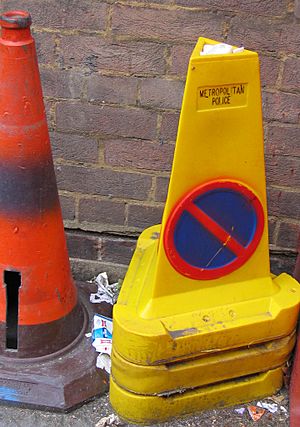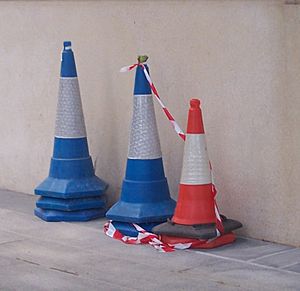Traffic cone facts for kids

Traffic cones are bright, cone-shaped markers often seen on roads. People also call them road cones, safety cones, or pylons. They are usually made from plastic and are placed on roads to help guide cars and other vehicles safely. They are a temporary way to change how traffic flows or to warn drivers about something ahead.
Contents
Why We Use Traffic Cones
Traffic cones are super helpful for keeping people safe on the road. They are often placed around areas where construction work is happening or where there has been a car accident. This helps drivers know to slow down and be careful.
- Protecting Workers: Companies that work on power lines or telephone cables often put cones on the road. This warns drivers that workers are nearby and helps keep them safe while they do their jobs.
- Learning to Drive: Driving schools use cones to set up special courses. These courses help new drivers practice important skills like turning, parking, and steering.
- Other Fun Uses: Beyond roads, cones are used for many other things! They can mark out paths for bike training, be used in sports games, or even help people save a parking spot for a short time.
What Do Traffic Cones Look Like?
Traffic cones are designed to be easy to see and move around.
- Size and Shape: Most traffic cones are about 60 cm (24 inches) tall. Their cone shape makes them stable, so they don't easily tip over, but they are light enough to be moved quickly by hand.
- Bright Colors: You'll usually see traffic cones in very bright colors like orange, yellow, or red. These colors stand out against the road and natural surroundings, making them easy for drivers to spot from a distance.
- Seeing at Night: Many cones have special reflective strips or paint. These reflective parts glow brightly when car headlights shine on them. This makes the cones much easier to see at night or in bad weather, which is very important for safety.
The History of Traffic Cones
Traffic cones have been around for a long time, helping to keep our roads safe.
- Who Invented Them?: The first traffic cones were invented in 1914 by a person named Charles P. Rudabaker.
- Early Cones: When they were first made, traffic cones were quite heavy because they were built from concrete.
- Modern Cones: Today, almost all traffic cones are made from brightly-colored plastic. This makes them much lighter, easier to move, and more durable than the old concrete ones.
Images for kids
-
Cones in use at the entrance to the George Washington Bridge in Fort Lee, New Jersey
-
Giant traffic cone in Seattle, Washington
-
Duke of Wellington statue, with cone (and reserve cones on standby)
-
Prank in Raglan, New Zealand
See also
 In Spanish: Cono de tráfico para niños
In Spanish: Cono de tráfico para niños






